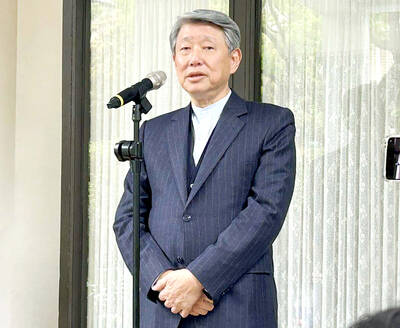The US dollar yesterday held close to a six-month peak, as jitters over China and global growth weighed on risk appetite, while the yen strengthened as Japan’s top currency diplomat sent a warning about the currency after it earlier dropped to a 10-month low.
The yen rose by as much as 0.4 percent to ¥147.02 per US dollar after Japanese Vice Minister of Finance for International Affairs Masato Kanda said the ministry would not rule out options if speculative moves persist, the strongest warning since last month.
Kanda has been the central figure in the nation’s efforts to stem the sharp decline of the yen since last year.

Photo: Reuters
The yen has hovered at about the key ¥145-per-US dollar level for the past few weeks. As of 8:13am GMT, it stood at ¥147.47 per US dollar, compared with ¥147.82 earlier in the session, which was its lowest since Nov. 4 last year.
“The remarks suggest that intervention could be imminent with the yen in the intervention zone we saw last year,” ING Groep NV global head of markets Chris Turner said.
Japan intervened in currency markets 12 months ago when the US dollar rose past ¥145, prompting the Ministry of Finance to buy the yen and push the pair back to about ¥140.
“I think we’ll probably see intervention, but that doesn’t necessarily mean the underlying trend will turn around any time soon,” Turner said, citing the US dollar’s ongoing strength.
Against a basket of currencies, the US dollar was at 104.77, not far off the six-month high of 104.90 touched on Tuesday. Economic data from China and Europe on Tuesday fanned some fears of slowing global growth, pushing investors to scramble for the greenback.
“Dollar strength remains the dominant play,” Oversea-Chinese Banking Corp currency strategist Christopher Wong (黃經隆) said in Singapore.
Higher-for-longer US interest rates and the relative US growth resilience are supporting the greenback, Wong said.
The euro was up 0.1 percent at US$1.0733, having fallen to a three-month low of US$1.0705 on Tuesday. Sterling was last at US$1.2559. It also touched a three-month low of US$1.25285 on Tuesday.
The New Taiwan dollar yesterday fell against the US dollar, down 0.23 percent to close at NT$31.967, while the Chinese yuan fell to a 10-month low against the greenback before paring some losses as state banks stepped in to offer support.
Similar currency defense measures exist elsewhere in Asia. Taiwan’s foreign exchange reserves declined last month for the first time in nearly a year, as the monetary authority intervened in the market.
In Thailand, the central bank has warned that rapid moves in the baht would prompt intervention.
Still, skepticism remains whether these measures are game changers in the absence of a less hawkish US Federal Reserve or a pickup in China’s economy.
Additional reporting by Bloomberg

MULTIFACETED: A task force has analyzed possible scenarios and created responses to assist domestic industries in dealing with US tariffs, the economics minister said The Executive Yuan is tomorrow to announce countermeasures to US President Donald Trump’s planned reciprocal tariffs, although the details of the plan would not be made public until Monday next week, Minister of Economic Affairs J.W. Kuo (郭智輝) said yesterday. The Cabinet established an economic and trade task force in November last year to deal with US trade and tariff related issues, Kuo told reporters outside the legislature in Taipei. The task force has been analyzing and evaluating all kinds of scenarios to identify suitable responses and determine how best to assist domestic industries in managing the effects of Trump’s tariffs, he

TIGHT-LIPPED: UMC said it had no merger plans at the moment, after Nikkei Asia reported that the firm and GlobalFoundries were considering restarting merger talks United Microelectronics Corp (UMC, 聯電), the world’s No. 4 contract chipmaker, yesterday launched a new US$5 billion 12-inch chip factory in Singapore as part of its latest effort to diversify its manufacturing footprint amid growing geopolitical risks. The new factory, adjacent to UMC’s existing Singapore fab in the Pasir Res Wafer Fab Park, is scheduled to enter volume production next year, utilizing mature 22-nanometer and 28-nanometer process technologies, UMC said in a statement. The company plans to invest US$5 billion during the first phase of the new fab, which would have an installed capacity of 30,000 12-inch wafers per month, it said. The

Taiwan’s official purchasing managers’ index (PMI) last month rose 0.2 percentage points to 54.2, in a second consecutive month of expansion, thanks to front-loading demand intended to avoid potential US tariff hikes, the Chung-Hua Institution for Economic Research (CIER, 中華經濟研究院) said yesterday. While short-term demand appeared robust, uncertainties rose due to US President Donald Trump’s unpredictable trade policy, CIER president Lien Hsien-ming (連賢明) told a news conference in Taipei. Taiwan’s economy this year would be characterized by high-level fluctuations and the volatility would be wilder than most expect, Lien said Demand for electronics, particularly semiconductors, continues to benefit from US technology giants’ effort

‘SWASTICAR’: Tesla CEO Elon Musk’s close association with Donald Trump has prompted opponents to brand him a ‘Nazi’ and resulted in a dramatic drop in sales Demonstrators descended on Tesla Inc dealerships across the US, and in Europe and Canada on Saturday to protest company chief Elon Musk, who has amassed extraordinary power as a top adviser to US President Donald Trump. Waving signs with messages such as “Musk is stealing our money” and “Reclaim our country,” the protests largely took place peacefully following fiery episodes of vandalism on Tesla vehicles, dealerships and other facilities in recent weeks that US officials have denounced as terrorism. Hundreds rallied on Saturday outside the Tesla dealership in Manhattan. Some blasted Musk, the world’s richest man, while others demanded the shuttering of his